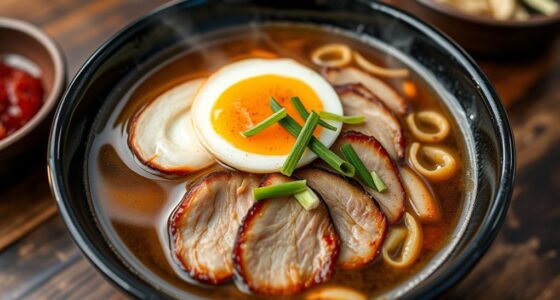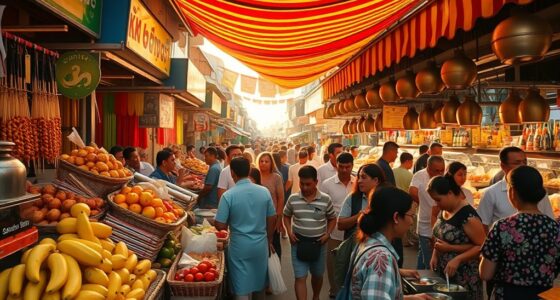Begin a street food safari through Southeast Asia’s night markets, where lively atmospheres, authentic dishes, and cultural stories collide. From Bangkok’s Pad Thai to Ho Chi Minh’s Pho and Kuala Lumpur’s diverse offerings, you’ll discover rich flavors and vibrant vendor traditions. These markets also support local economies, preserve culinary heritage, and offer lively entertainment. Keep exploring to uncover how these bustling hubs continue to thrive despite challenges and stay true to their roots.
Key Takeaways
- Southeast Asia’s night markets are vibrant open-air food hubs showcasing authentic street cuisine and cultural traditions.
- Must-try dishes include Pad Thai, Pho, Som Tam, char kuey teow, satay, and Assam Laksa.
- Markets serve as cultural “living museums,” preserving regional culinary techniques and community heritage.
- They boost local economies through tourism, vendor livelihoods, and support for traditional food practices.
- Digital marketing helps vendors share stories, attract visitors, and sustain authenticity amid growing competition.
The Vibrant World of Southeast Asian Night Markets

Southeast Asian night markets burst with energy and color, offering a lively fusion of food, shopping, and social interaction that draws locals and tourists alike. The night market architecture often features open-air layouts with densely packed stalls lining streets near temples or community centers, creating a vibrant, immersive environment. As you explore, you’ll notice vendor storytelling through their displays and conversations, sharing traditions and personal histories that bring the market to life. These stalls aren’t just places to buy goods—they’re stages for cultural expression, where vendors connect with visitors through lively calls and stories. The dynamic setup, combined with the rich narratives told by vendors, makes every visit a sensory journey into local heritage and community spirit. Night markets historically played a significant role in Chinese urban social and economic life, which has influenced their widespread popularity across Southeast Asia. Additionally, the cultural significance of these markets continues to thrive as they adapt to modern influences while preserving traditional practices.
Must-Try Dishes at Famous Market Spots

When exploring famous market spots, you can’t miss Bangkok’s iconic Pad Thai or Ho Chi Minh’s flavorful Pho. These dishes capture the essence of their cities’ food cultures and are must-tries for any street food lover. Get ready to taste authentic flavors that define each vibrant market scene. Traditional and popular foods like these showcase the rich culinary heritage that makes Southeast Asia’s night markets so unique.
Bangkok’s Thai Classics
Are you ready to taste Bangkok’s most iconic Thai dishes? At these lively night markets, you can enjoy classic favorites like Pad Thai, with stir-fried noodles, eggs, and peanuts, or Som Tam, a spicy green papaya salad packed with chilies and lime. Don’t miss Moo Ping—smoky grilled pork skewers that make perfect quick bites. Khao Pad, flavorful Thai fried rice, and sweet Mango Sticky Rice complete the experience. Vendors at places like Jodd Fairs and Chatuchak often blend traditional recipes with night market innovations, making street food sustainability a priority by supporting local producers and reducing waste. Sampling these dishes immerses you in authentic flavors while enjoying Bangkok’s vibrant market atmosphere, where tradition meets modern street food creativity.
Ho Chi Minh’s Pho
Ever wondered where to find the best pho in Ho Chi Minh City’s bustling night markets? You’ll discover that pho traditions run deep here, with stalls serving up authentic flavors that highlight market authenticity. The broth, slow-simmered for hours with star anise, cinnamon, and cloves, forms the heart of each bowl, offering a clear, aromatic base. Use traditional cooking techniques to achieve that perfect depth of flavor that sets these stalls apart. Fresh herbs like Thai basil, coriander, and spring onions are always provided, allowing you to customize your pho to your taste. Popular markets like Ben Thanh and Binh Tay showcase the city’s rich culinary heritage, with vendors adding lime, chili, and sauces for extra flair. Whether you prefer beef or chicken, enjoying pho at these lively markets connects you to Ho Chi Minh’s vibrant street food culture and time-honored culinary traditions. Many stalls operate late into the night, ensuring you can indulge in this comforting dish whenever cravings strike.
Kuala Lumpur’s Malaysian Flavors
Kuala Lumpur’s vibrant street food scene offers a rich tapestry of flavors at its most iconic market spots. At Taman Connaught Night Market, you’ll find diverse cuisines, from stinky tofu to char kuey teow, with vendors trained to serve authentic dishes using sustainable packaging. The market’s emphasis on vendor training ensures quality and consistency across stalls, enhancing the overall dining experience. Jalan Alor is famous for late-night delights like BBQ stingray and fried oyster omelet, creating an energetic dining atmosphere. Petaling Street offers a mix of Chinese-Malay fusion foods like roasted duck rice and assam laksa, highlighting Malaysia’s multicultural palette. OUG Night Market provides a local vibe with char kuey teow, satay, and traditional desserts, emphasizing vendor training for quality. These markets combine tradition with eco-friendly practices, making every bite a taste of Malaysia’s vibrant culinary heritage.
The Cultural Significance of Night Market Cuisine
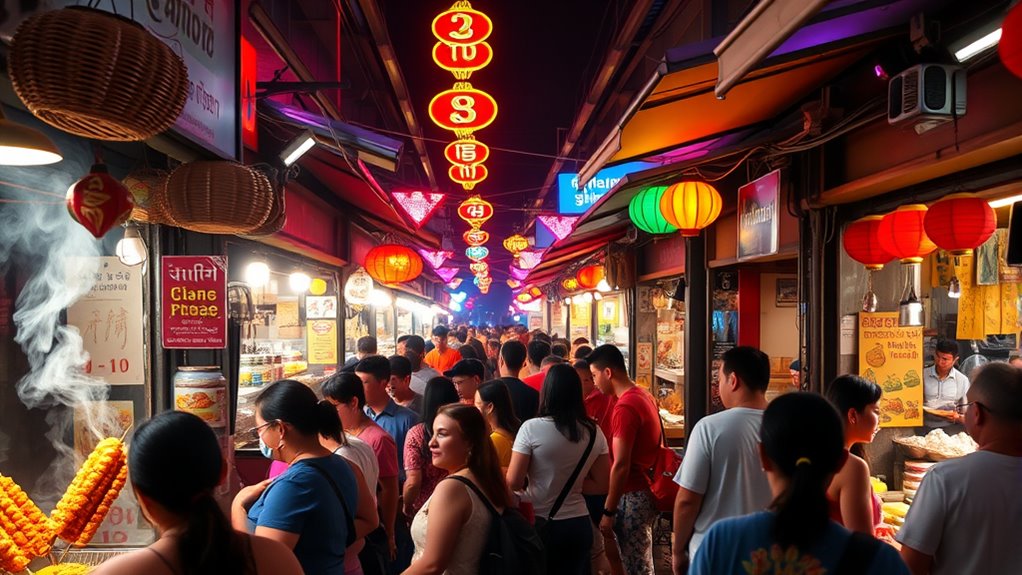
You see, night market cuisine is more than just food—it’s a living record of cultural heritage and identity. When you taste traditional dishes, you’re experiencing stories and customs passed down through generations. These flavors help preserve unique traditions and keep cultural roots alive amidst modern changes. Night markets serve as vibrant repositories of history, where each dish tells a story of regional influences and local artistry. The use of traditional cooking methods further enriches these culinary narratives, connecting present-day vendors and diners to their ancestors.
Culinary Heritage Preservation
Culinary heritage preservation is essential to maintaining the cultural identity of night markets, where traditional cooking techniques and recipes are actively passed down through generations. By practicing authentic culinary techniques like pounding with mortar and pestle, vendors preserve the texture and flavor of dishes such as Thai papaya salad and Lao jeow sauce. Heritage documentation plays a crucial role, with families safeguarding recipes and methods that reflect deep-rooted histories. Local ingredients like fish sauce, tamarind, and shrimp paste ensure the distinctive umami flavor remains intact, connecting current practices with ancestral traditions. Food in Southeast Asia serves as a social glue, reinforcing the importance of these culinary traditions in community bonding. These traditions are reinforced through communal activities and family-run businesses, creating a living record of culinary history. Recognizing the significance of cultural preservation helps secure the future of these vibrant food traditions; official recognition, such as UNESCO status, further supports efforts to protect and pass on Southeast Asia’s vibrant food heritage.
Cultural Identity Expression
Have you ever noticed how night markets serve as vibrant spaces where communities express their cultural identity through food? These markets showcase cultural authenticity by preserving traditional recipes, cooking methods, and regional flavors. As you explore, you’ll see how local dishes tell stories of migration, history, and shared heritage. Vendors and patrons participate in cultural dialogue, strengthening community resilience and fostering a sense of belonging. Night markets often feature traditional performances and communal celebrations, emphasizing local customs and rituals. The informal environment encourages diverse socioeconomic groups to connect, preserving inclusiveness. By resisting commercialization and prioritizing indigenous culinary practices, these markets act as living museums—celebrating cultural diversity, innovation, and pride through vibrant, authentic cuisine. Additionally, they serve as cultural identity expression spaces that uphold and transmit regional culinary traditions to future generations.
How Night Markets Boost Local Economies

Night markets play an essential role in strengthening local economies by creating numerous employment opportunities and stimulating demand for goods and services. They have a significant economic impact by providing jobs for vendors, support staff, and informal workers, including vulnerable groups like women and migrants. These markets support diverse entrepreneurial ventures, from food stalls to apparel, boosting local skillsets. The economic benefits extend beyond direct sales, as they generate income for local suppliers and service providers. Night markets also attract tourists, increasing revenue through cultural experiences and affordable products. This tourism helps boost foreign exchange earnings and sustains traditional crafts. Overall, night markets promote cultural preservation while enhancing community income, making them crucial engines for local economic resilience and social cohesion. Additionally, the variety of offerings and vibrant atmosphere often reflect the local culture, which can be further understood through Personality Traits, enhancing visitors’ cultural appreciation.
Navigating Food Safety and Quality in the Night Market Scene
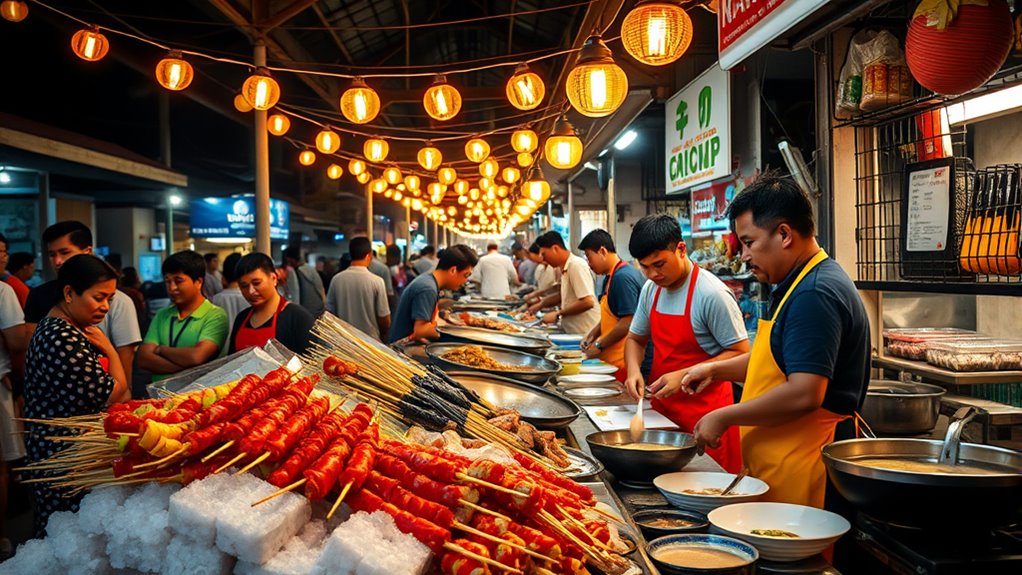
Managing food safety and quality at night markets requires vigilance, as the off-premise and street-side setting often pose unique risks. Vendor hygiene practices and environmental factors influence contamination risks. To navigate safely, observe vendors’ handwashing, utensil cleanliness, and overall hygiene. Avoid raw or undercooked foods, especially seafood and meat, and prefer freshly cooked, hot dishes. Be aware that poor temperature control and high work pressure can compromise food safety. Use this table to assess risks:
| Aspect | Consideration |
|---|---|
| Vendor Hygiene | Check for clean hands, gloves, and utensils |
| Food Handling | Ensure proper storage and cooking temperatures |
| Environment Support | Look for clean stall surroundings |
| Food Freshness | Prefer freshly cooked, hot foods |
| Contamination Risks | Be cautious of cross-contamination sources |
Additionally, understanding food safety principles can help you make informed choices and reduce health risks during your night market experience.
The Social and Entertainment Aspects of Night Markets
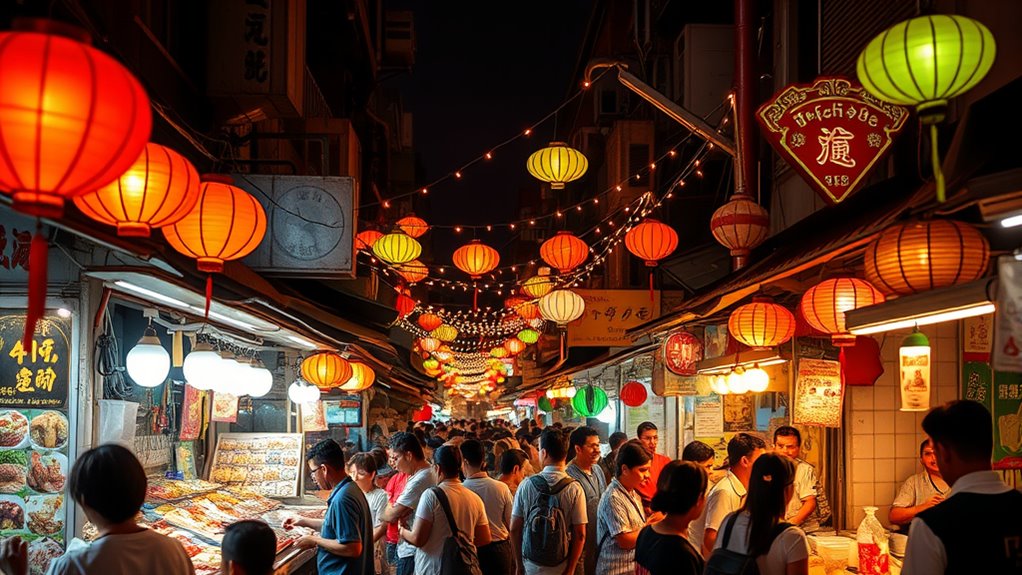
Understanding food safety and quality is essential for a positive night market experience, but these vibrant venues are about more than just eating. Night markets are lively hubs of community bonding and social vitality, where locals and tourists gather to connect beyond transactions. You’ll notice families, friends, and intergenerational groups sharing meals, playing games, and enjoying street performances. These activities foster a sense of belonging and preserve cultural traditions, turning night markets into dynamic entertainment spaces. The lively atmosphere encourages casual socializing, making it easy to meet new people or strengthen existing bonds. While some challenges like noise and congestion exist, the overall social energy and inclusivity of night markets create a unique space that enriches community life and cultural expression. Incorporating community engagement initiatives can further enhance the sense of connection and shared experience among visitors.
Challenges Facing Night Market Vendors and Authorities

Vendors operating at night markets often face a complex web of regulatory and legal hurdles that hinder their ability to thrive. Regulatory hurdles, such as the lack of designated vending zones and inconsistent enforcement, create uncertainty and risk of eviction, making it hard to plan long-term. Without formal recognition, vendors struggle to access legal protections, leaving them vulnerable to sudden policy shifts. Financial constraints compound these challenges, as many rely on personal savings and face limited access to microcredit or formal financial services. Intense competition among small vendors drives prices down, squeezing profit margins further. Environmental disruptions and strict urban policies add to operational difficulties. Overall, these regulatory and financial obstacles restrict growth, jeopardize livelihoods, and hinder the sustainable development of night market vendors. Moreover, risk assessment of these challenges is essential to develop effective strategies for sustainable vendor support and growth.
Leveraging Digital Tools for Market Promotion
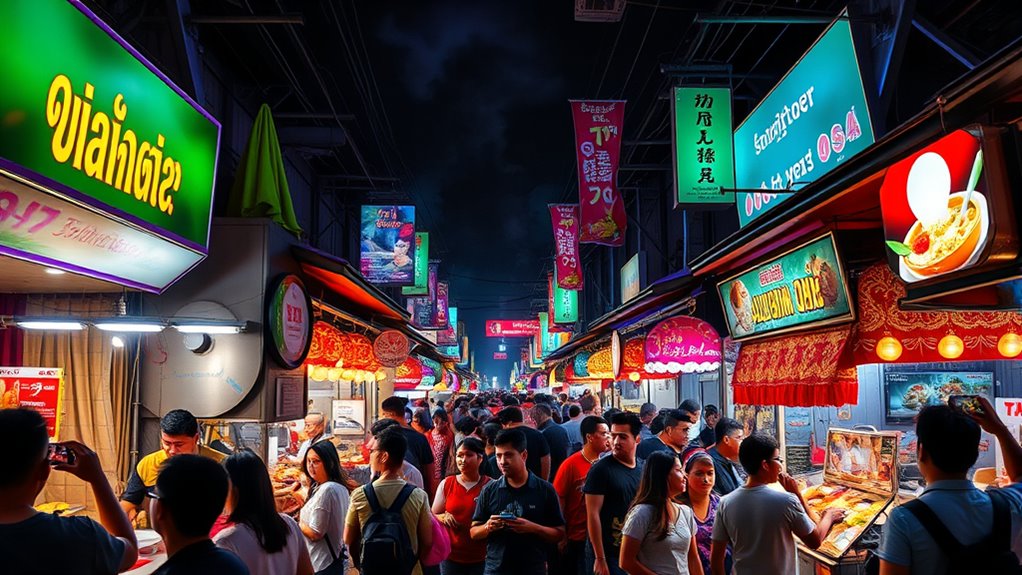
Digital tools have transformed how night market vendors promote their offerings, making it easier to reach broader audiences and build brand awareness. You can harness social media platforms like Facebook, Instagram, and TikTok to showcase your food and engage consumers. Here’s how: 1. Use digital storytelling to share your market’s unique history, culture, and food stories, creating a stronger emotional connection. 2. Collaborate with local influencers or celebrities to expand your reach and build trust with target audiences. 3. Implement location-based targeting and SEO strategies to attract both tourists and locals searching for street food experiences. 4. Incorporate well-being tips such as comfortable seating and clean environments to enhance customer satisfaction and encourage repeat visits. These methods not only boost visibility but also foster community engagement, making your night market a must-visit destination in Southeast Asia.
Preserving Authenticity Amid Growing Competition
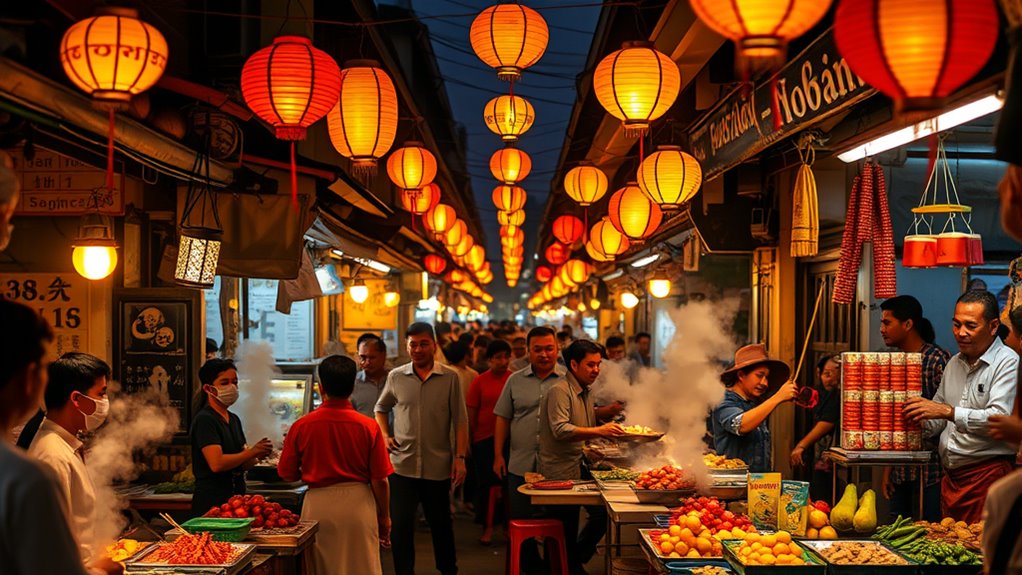
As night markets face increasing competition from modern retail and entertainment options, maintaining authenticity becomes more essential than ever. Vendor authenticity relies on preserving traditional recipes, craftsmanship, and cultural storytelling, which create genuine experiences for visitors. However, cultural commercialization poses a challenge, as markets risk diluting their heritage to attract tourists. To combat this, vendors focus on fostering cultural connections over commercial gains, emphasizing authentic interactions that build trust and loyalty. Supporting traditional skills and resisting excessive modernization help retain the market’s unique identity. Collaboration with local authorities and cultural groups is essential to safeguard these practices amid urban development and rising competition. Additionally, emphasizing sustainable practices can help preserve the heritage and ensure that night markets remain vibrant cultural hubs. By prioritizing authenticity, night markets can continue to serve as living museums of Southeast Asian culture, ensuring their legacy endures.
Frequently Asked Questions
How Do Night Markets Adapt to Changing Food Safety Regulations?
You see how night markets adapt to changing food safety regulations by implementing food safety innovations and vendor compliance strategies. Vendors often adopt new hygiene practices, like improved sanitation and safe water use, to meet updated standards. They participate in certification programs, display grading signs, and undergo regular inspections. These efforts help vendors stay compliant, boost consumer confidence, and continuously elevate food safety standards in the dynamic environment of night markets.
What Are the Environmental Impacts of Night Market Operations?
They say “prevention is better than cure,” and that’s true for environmental impacts. Night market operations cause significant waste management challenges, with plastic and organic waste piling up. Plus, high energy consumption from excessive lighting harms local ecosystems and increases emissions. These issues threaten sustainability, so it’s essential to adopt eco-friendly practices, manage waste properly, and reduce energy use to protect both the environment and community health.
How Do Vendors Maintain Authenticity While Competing With Modern Outlets?
You maintain vendor authenticity by preserving traditional recipes, cooking techniques, and using locally sourced ingredients, which supports cultural preservation. By presenting dishes with authentic flavors and local presentation styles, you highlight your unique culinary identity. Participating in festivals and engaging with the community reinforces your commitment to cultural preservation. Balancing modern hygiene standards with traditional methods helps you compete with modern outlets while keeping your culinary authenticity intact.
What Role Do Local Governments Play in Supporting Night Markets?
Did you know that over 80% of night markets worldwide receive support from local governments? They play a vital role in urban planning by issuing licenses, zoning areas, and regulating stall placement, which keeps markets organized and accessible. This support also promotes cultural preservation by enforcing standards that highlight local traditions and cuisine. Governments collaborate with vendor associations, ensuring safety, hygiene, and a vibrant atmosphere that attracts both locals and tourists.
How Can Tourists Identify the Highest Quality Street Food Vendors?
To spot the best street food vendors, pay attention to vendor hygiene and customer reviews. Look for vendors with clean cooking surfaces, utensils, and proper food storage, which show good sanitation. Check customer reviews or ask locals; repeated visits and positive feedback often mean reliable quality. Vendors with visible cleanliness practices, like glove use or organized stalls, and high ratings are usually the safest and tastiest choices for you.
Conclusion
As you wander through Southeast Asia’s night markets, you might stumble upon unexpected flavors and stories behind each stall. It’s a coincidence how these vibrant spots not only satisfy your cravings but also boost local livelihoods and preserve rich traditions. Embrace the chaos, savor every bite, and realize that your journey into these bustling markets connects you to a culture that’s as lively and unpredictable as the street food itself.


